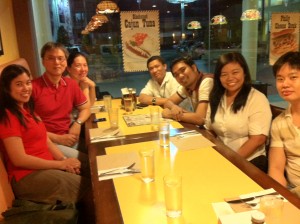- APNIC Network Security Training at Baguio, Philippines
University of the Cordilleras
3F-Main Building,
Gov. Pack Road
Baguio, Philippines
Author: admin
Baguio’s Panagbenga 2013 Flower festival live stream!!
It’s time, once again, to dance on the streets of Baguio as the Panagbenga Festival officially opens on February 1! With a Grand Opening Parade from Panagbenga Park to Athletic Bowl, the first day of Panagbenga will set the festive mood as the month-long celebration starts!
Watch Baguio’s Panagbenga 2013 Flower festival live stream brought to you by Baguio City Government, Pixel hub and BNSHosting.
Visit this link: http://www.panagbengaflowerfestival.com/live/
APNIC Network Security Workshop BAGUIO, PHILIPPINES 20-22 Feb 2013
APNIC is pleased to announce that we will be conducting the following training course in BAGUIO, PHILIPPINES with the support of Bitstop Network Services and the University of Cordillera.
Course: Network Security Workshop (3 days)
Dates: FEB 20-22, 2013
Venue: University of the Cordilleras
3F-Main Building,
Gov. Pack Road
Baguio, PHILIPPINES
Contact: Nancy M. Flores
Dean, UC-CITCS
Tel: 442-3316 loc. 131
Email: nancy@uc-bcf.edu.ph
Fees: Pay onsite Early Bird
(cash only) (credit card)
———– ————-
APNIC Members PHP 5,200 AUD 96
Standard PHP 7,800 AUD 144
NOTES
—–
– Training course run from 0900h – 1700h local time
– Participants are advised to bring their own laptop computers for
hands-on lab exercises
– Lunch and refreshments will be provided
– Training certificate is provided upon successful completion of the
course
– Seats are limited and registration is on a “first come, first
served” basis
– Registration priority is given to APNIC Members
– Early Bird rates end on 20 January 2013
REGISTRATION NOW OPEN
———————
For registration and course information, please go to:
http://www.apnic.net/events/calendar/training/2013/netsec-20Feb13
You will receive a confirmation email shortly after completing your online registration.
CANCELLATION POLICY
——————–
Cancellations will incur a 10 per cent administration fee. Cancellations made less than five working days before the training event will not be eligible for a refund. If you cannot attend an event, you can nominate a substitute.
To read the full Training Event Cancellation Policy go to:
http://www.apnic.net/cancellation-policy
If you would like to receive upcoming training announcements, please subscribe to our mailing list:
http://mailman.apnic.net/mailman/listinfo/training-announce
From: Champika Wijayatunga
Training Manager
————————————————————————
APNIC Training training@apnic.net
Asia Pacific Network Information Centre (APNIC) Tel: +61-7-3858-3100
PO Box 3646 Fax: +61-7-3858-3199
6 Cordelia Street, South Brisbane,
QLD 4101 Australia http://www.apnic.net/training
————————————————————————
E-Commerce Boot Camp – Face to Face Session
To strengthen our ongoingE-Commerce Boot Camp online, we will be having a series of face-to-face events where participants can join and get the help needed in making their e-commerce project a reality.
The following are our up-coming schedules:
January 11, 2013 – University of the Philippines Information Technology Development Center
2/F Vidal A. Tan Hall, Quirino Ave. cor. Velasquez St., University of the Philippines, Diliman, Quezon City
February 9, 2013 – The Center Suites Cebu
Brgy. Camputhaw, Gonzales Compd., Escario Street, Cebu City, Philippines, 6000
The event will be from 9 am to 5 pm. The fee is P700 for early bird rate and can be availed by those registering on or before December 31, 2012. Regular rate is P1000. Light lunch is included.
Agenda:
8:00 to 9:00 Registration
9:00 to 9:30 Introduction to E-Commerce Boot Camp participants
9:30 to 12:00 E-Commerce Workshop
– Business Model Canvas (customer analysis, business pattern)
– E-Commerce Strategy
– Customer Support Policies
12:00 to 1:00 Lunch
1:00 to 3:00 E-Commerce Workshop
– Internet Marketing and Advertising
– E-Commerce Project Plan
– E-Commerce Safety
3:00 to 4:00 E-Commerce Project Presentation
(to be made by participants who would like to share what they are currently working on and get direct feedback)
Cybercrime and Data Privacy Laws
Cybercrime and Data Privacy Laws: What Every Digital Influencer Needs to Know by Atty. JJ Disini
from Janette Toral 3 weeks ago
With the passage of Cybercrime Prevention Act of 2012 (digitalfilipino.com/introduction-cybercrime-prevention-act-republic-act-10175/) and Data Privacy Act of 2012 (digitalfilipino.com/republic-act-no-10173-data-privacy-act-of-2012/), new opportunities and challenges are to be hurdled in the social media. In this session, Atty. JJ Disini (disini.ph) gave an overview on what digital influencers need to know about these laws and the responsibilities that we need to keep in mind.
JJ delivered this presentation at the Digital Influencers Marketing Summit last September 29, 2012 at SMX Convention Center organized by DigitalFilipino.com (digitalfilipino.com).
source: http://vimeo.com/53860327
Yahoo Tips: Faster Websites.
Minimize HTTP Requests
80% of the end-user response time is spent on the front-end. Most of this time is tied up in downloading all the components in the page: images, stylesheets, scripts, Flash, etc. Reducing the number of components in turn reduces the number of HTTP requests required to render the page. This is the key to faster pages.
One way to reduce the number of components in the page is to simplify the page’s design. But is there a way to build pages with richer content while also achieving fast response times? Here are some techniques for reducing the number of HTTP requests, while still supporting rich page designs.
Combined files are a way to reduce the number of HTTP requests by combining all scripts into a single script, and similarly combining all CSS into a single stylesheet. Combining files is more challenging when the scripts and stylesheets vary from page to page, but making this part of your release process improves response times.
CSS Sprites are the preferred method for reducing the number of image requests. Combine your background images into a single image and use the CSS background-image and background-position properties to display the desired image segment.
Image maps combine multiple images into a single image. The overall size is about the same, but reducing the number of HTTP requests speeds up the page. Image maps only work if the images are contiguous in the page, such as a navigation bar. Defining the coordinates of image maps can be tedious and error prone. Using image maps for navigation is not accessible too, so it’s not recommended.
Inline images use the data: URL scheme to embed the image data in the actual page. This can increase the size of your HTML document. Combining inline images into your (cached) stylesheets is a way to reduce HTTP requests and avoid increasing the size of your pages. Inline images are not yet supported across all major browsers.
Reducing the number of HTTP requests in your page is the place to start. This is the most important guideline for improving performance for first time visitors. As described in Tenni Theurer’s blog postBrowser Cache Usage – Exposed!, 40-60% of daily visitors to your site come in with an empty cache. Making your page fast for these first time visitors is key to a better user experience.
Use a Content Delivery Network
tag: server
The user’s proximity to your web server has an impact on response times. Deploying your content across multiple, geographically dispersed servers will make your pages load faster from the user’s perspective. But where should you start?
As a first step to implementing geographically dispersed content, don’t attempt to redesign your web application to work in a distributed architecture. Depending on the application, changing the architecture could include daunting tasks such as synchronizing session state and replicating database transactions across server locations. Attempts to reduce the distance between users and your content could be delayed by, or never pass, this application architecture step.
Remember that 80-90% of the end-user response time is spent downloading all the components in the page: images, stylesheets, scripts, Flash, etc. This is the Performance Golden Rule. Rather than starting with the difficult task of redesigning your application architecture, it’s better to first disperse your static content. This not only achieves a bigger reduction in response times, but it’s easier thanks to content delivery networks.
A content delivery network (CDN) is a collection of web servers distributed across multiple locations to deliver content more efficiently to users. The server selected for delivering content to a specific user is typically based on a measure of network proximity. For example, the server with the fewest network hops or the server with the quickest response time is chosen.
Some large Internet companies own their own CDN, but it’s cost-effective to use a CDN service provider, such as Akamai Technologies, EdgeCast, or level3. For start-up companies and private web sites, the cost of a CDN service can be prohibitive, but as your target audience grows larger and becomes more global, a CDN is necessary to achieve fast response times. At Yahoo!, properties that moved static content off their application web servers to a CDN (both 3rd party as mentioned above as well as Yahoo’s own CDN) improved end-user response times by 20% or more. Switching to a CDN is a relatively easy code change that will dramatically improve the speed of your web site.
Add an Expires or a Cache-Control Header
tag: server
There are two aspects to this rule:
- For static components: implement “Never expire” policy by setting far future
Expiresheader - For dynamic components: use an appropriate
Cache-Controlheader to help the browser with conditional requests
Web page designs are getting richer and richer, which means more scripts, stylesheets, images, and Flash in the page. A first-time visitor to your page may have to make several HTTP requests, but by using the Expires header you make those components cacheable. This avoids unnecessary HTTP requests on subsequent page views. Expires headers are most often used with images, but they should be used on allcomponents including scripts, stylesheets, and Flash components.
Browsers (and proxies) use a cache to reduce the number and size of HTTP requests, making web pages load faster. A web server uses the Expires header in the HTTP response to tell the client how long a component can be cached. This is a far future Expires header, telling the browser that this response won’t be stale until April 15, 2010.
Expires: Thu, 15 Apr 2010 20:00:00 GMT
If your server is Apache, use the ExpiresDefault directive to set an expiration date relative to the current date. This example of the ExpiresDefault directive sets the Expires date 10 years out from the time of the request.
ExpiresDefault "access plus 10 years"
Keep in mind, if you use a far future Expires header you have to change the component’s filename whenever the component changes. At Yahoo! we often make this step part of the build process: a version number is embedded in the component’s filename, for example, yahoo_2.0.6.js.
Using a far future Expires header affects page views only after a user has already visited your site. It has no effect on the number of HTTP requests when a user visits your site for the first time and the browser’s cache is empty. Therefore the impact of this performance improvement depends on how often users hit your pages with a primed cache. (A “primed cache” already contains all of the components in the page.) We measured this at Yahoo! and found the number of page views with a primed cache is 75-85%. By using a far future Expires header, you increase the number of components that are cached by the browser and re-used on subsequent page views without sending a single byte over the user’s Internet connection.
Establishment of the Association for Small-to-Medium Sized Call Centers in the Philippines:Philcall
We would like to reach out to the different ICT councils, so that, you can help forward this invitation to some of your members that we are trying to reach out to.
I hope you can even encourage them to at least participate with our first meeting in a long time. One of the executive officers of PhilCall is also the co-founder of the Pangasinan ICT chapter, Ronald Punzalan.
We would like to invite them to join a short 3~4 hour round table discussion that will be held in Rastro Tapas Bar and Restaurant in Burgos Circle, Bonifacio Global City, Taguig at 1pm on November 6, 2012.
The Philippine Call Center Alliance, Inc. (PhilCall) is an association for the Small-to-medium sized enterprise (SME), and, Filipino-owned call centers all over the country. These are for call centers with an operating seat capacity ranging from 10 to 1500 seats per company.
We are reactivating PhilCall since we need an organization that will represent our real needs to make our businesses grow and develop further. PhilCall’s primary objectives are to unify the contact center SME industry, representing the member’s individual and collective interests in policy making, standard setting, and, serving as a prime catalyst for industry development.
“From fred Chua:”





